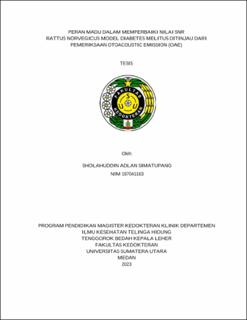Peran Madu dalam Memperbaiki Nilai SNR Rattus Norvegicus Model Diabetes Melitus Ditinjau dari Pemeriksaan Otoacoustic Emission (OAE)
The Role of Honey in Repairing Cochlear Hair Cell Damage in Rattus Norvegicus Diabetes Mellitus Model as Assessed by Otoacoustic Emission (OAE) Examination

Date
2023Author
Simatupang, Sholahuddin Adlan
Advisor(s)
Haryuna, Tengku Siti Hajar
Farhat
Metadata
Show full item recordAbstract
The World Health Organization (WHO) estimates that the global prevalence of diabetes mellitus (DM) will rise from 171 million people in 2000 to 366 million by 2030. Indonesia is among the top 10 countries with the highest number of DM cases. This study aims to investigate the role of honey in preventing cochlear damage in a Rattus norvegicus DM model based on signal-to-noise ratio (SNR) values through otoacoustic emission (OAE) examination. Methods. This was an ex vivo laboratory experimental study with a pretest-posttest control group design. The research was conducted for five months at the Animal Laboratory/Animal House, Faculty of Mathematics and Natural Sciences (FMIPA), Universitas Sumatera Utara (USU). The study sample consisted of 25 healthy male white rats (Rattus norvegicus, Wistar strain), aged 2–3 months, weighing 150–250 grams, divided into five treatment groups. Each experimental unit was measured on days 0, 3, 6, 9, and 12, before and after honey administration. Results. Preventive administration of honey in the DM rat model showed that a dose of 1 g/kgBW/rat was more effective in increasing SNR values compared to 2 g/kgBW/rat. Conversely, in curative administration, a dose of 2 g/kgBW/rat yielded better results in protecting the cochlea from damage compared to the lower dose. Conclusion. Honey plays a role in preventing cochlear hair cell damage in Rattus norvegicus diabetes mellitus model as assessed by otoacoustic emission (OAE) examination.
